You know your major and minor chords and have heard of this diminished chord but are unsure how to use it in your music. I break down what a diminished triad is and provide a few examples on how it can function in music.
Typically, a diminished chord is used to create tension and a sense of destabilization in the music. Diminished chords are dissonant and “want” to be resolved to a consonance. In a major key they are the seven chord (vii-dim) and in minor keys they are the two chord (ii-dim).
Continue on to learn more about how this chord is built and how it functions in tonal music. In order for this article to not get too long, I’ll not be going over fully diminished, half diminished, or diminished intervals in this article.
How a diminished triad is built
The diminished triad is comprised of two minor thirds stack on top of each other (if you do not know what a minor third is, then check out my interval article) or a minor third and a diminished fifth. For example a B, D, F. It is called diminished because of that diminished fifth. In a major or minor chord the fifth would be a perfect fifth, but in the diminished chord it has been lowered by 1 half-step.
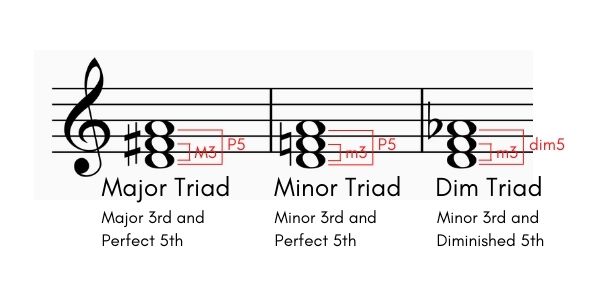
Diminished triad notation
There are a few different notations for diminished triads to be aware of.
| Type | Notation | Example |
| Roman Numerals | roman numeral followed by a superscript “o”. Any roman numeral followed by the superscript “o” is diminished not just seven or two chords. | viio |
| Chord Symbol | This notation is typically found in jazz or lead sheet style notation. | VII dim Bdim |
| Integer | This notation is typically used in Set Theory. A system of looking at music as numbers rather than dots on a staff. | 036 |
Function of diminished triads
The vii diminished chord in a major key
A vii-dim triad typically functions as a dominant. This means it is wanting to resolve to the tonic. Broadly speaking, tonal music has two poles pushing and pulling the music along: the tonic (the “I” chord of the home key) and the dominant (chords that provide tension and feel like they want to return to the stability of the tonic).
The chart below shows whether the chords function as tonic, dominant, or predominant in a major key.
| Chord | Predominant Function | Tonic Function | Dominant Function |
| Tonic (I) | X | ||
| Super Tonic (ii) | X | ||
| Mediant (III) | X | ||
| Subdominant (IV) | X | ||
| Dominant (V) | X | ||
| Submediant (vi) | X | ||
| Leading Tone (viio) | X |
What determines the function of chords
Without getting to deep at this point, it is context and how the composer treats the chords that determines function. In general triads that contain the leading tone (the seventh note in the major scale) will typically function as a dominant (but not the iii chord as you see in the example below). This is because our ears are trained to hear that leading tone as “wanting” to resolve to the tonic note.
The example below shows three progressions. The first two have a tonic-dominant-tonic relationship. The last one does not. The iii chord does not function as a dominant primarily because it shares two pitches with the tonic triad and does not create enough tension to have a dominant sound.
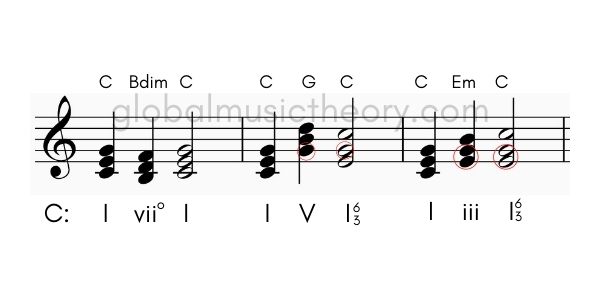
Function of a diminished chord in a minor key
In a minor key the seventh chord is can take a few different qualities because there are three types of minor scales that could be used.
| Minor Scale Type | Quality of Seventh Chord |
| Natural Minor | Major |
| Harmonic Minor | Diminished |
| Melodic Minor | Diminished or Major |
If the seventh chord has the diminished quality it will function as a dominant. It functions as a dominant because it has the leading tone in the chord. If the seventh chord has a major quality, it will then function as a predominant. Or better yet, the VII chord will function as a V chord in the relative major to get some modulation going!
Diminished chords and substitutions
If you followed the above discussion, then it is simple enough to follow the logic of which chords can swap in and out for each other. In tonal music it’s all about function when it comes to chord substitutions. Understanding what each chord is bringing to the music and where each chord is “leading” is essential. I believe it’s essential because it’s one of the way in which a composer can control two important aspects of tonal music: 1) variation (in particular through manipulation of harmony) and 2) expectations.
Dominant substitutions
The diminished seven chord can easily stand in for the five chord. Using the viio chord adds even more dissonance for a couple of reasons: 1) the diminished chord itself is more dissonant because it contains a diminished 5th rather than a perfect 5th and 2) the vii-dim shares no tones in common with the tonic (the V chord shares 1 pitch in common with the tonic making the V-I progression smoother than the viio -I)
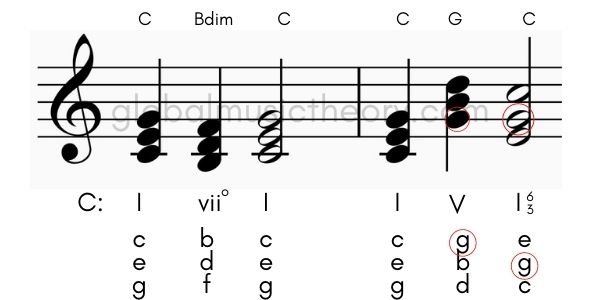
Diminished chords as a path to other chords
i-vii-i: Example from Bach Chorale
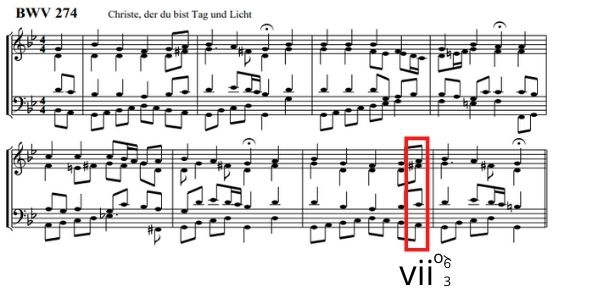
In the example above, the diminished seven chord is clearly a passing chord but shows how the pitches of the vii-dim chord still fulfils the function of the dominant. In the example the chord preceding the red box is a tonic (in 1st inversion) that moves to the vii-dim and then the chord after the red box is another tonic (in root position). This creates the expected movement of tonic-dominant-tonic.
This step-wise motion from the tonic to the vii to the tonic is one of the main uses of the diminished seven chord.
The diminished chords play a critical role in moving from one chord to another. Many time diminished chords are employed so that voice leading can be smooth. Look at the example below and notice the step-wise motion and maintenance of a common tone when moving between these chords.
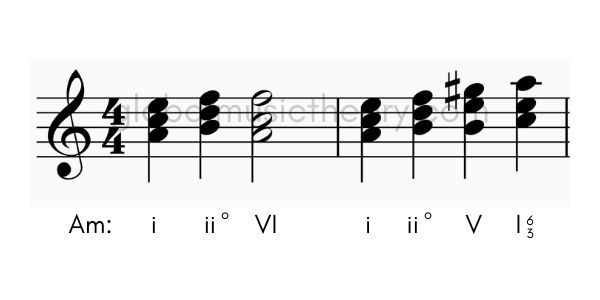
Typical Diminished Chord Voicing and Inversions
Voicing refers to how the notes of the chord are presented – where on the staff is each note. Below are some typical voicings.

The next consideration is which pitch will be the lowest (in the bass)? Determining which order (inversion) to place the notes will give the chord a different sound – even though you are using the same notes! Here are the three possible permutations of the three pitches that make up the B diminished triad.
When you combine the voicing with the inversion you get the following options for how to present this chord.
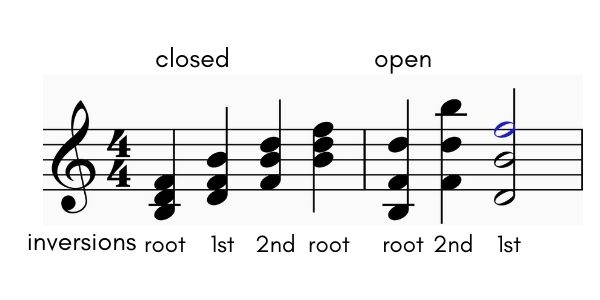
Typically, diminished chords are in the 2nd inversion. The main reason for this is that it softens the dissonance. You can test this on your own by playing an a C and B (one half step apart) and listen for the dissonance. Then move the B an octave higher and play C and the B again and now listen for the dissonance. You should be able to hear that it has been considerably reduced just by spacing the notes apart. If you want very intense dissonance, then bring the notes closer together. If you want a softer dissonance, spread the pitches apart.
The key to using any chord – diminished included
A final piece of advice when getting into chords and their functions and substitutions and the like: it’s all about voice leading. These “rules” about chords and where the “want” to go or how they function all stems from voice leading. Voice leading is the linear progression of each melodic line. Voice leading “rules” came from counterpoint. If you understand voice leading then you will understand chord progressions. Voice leading is the horizontal understanding and harmony (chords) are the vertical. Both have their place and use and when used in conjunction, you can write some great music! I like to use chord progressions as sign posts and then use voice leading to connect the sign posts.


Leave a Reply